Episode 162
What you’ll learn in this episode:
- Why an empty mind is the key to creative exploration
- The difference between an artist-jeweler and a jeweler or artist alone
- What Fairtrade gold is, and how Ute became a pioneer in the ethical jewelry movement
- Why greenwashing is the newest trend threatening the ethical jewelry market
- How jewelry creates connections, even when someone wouldn’t wear a piece themselves
About Ute Decker
Ute Decker, born 1969, Germany, lives and works in London, UK. The jewels of Ute Decker are described as “a powerful statement” that “sets a shining ethical example” (Financial Times). The Economist 1843 compares her “avant-garde sculptural pieces” to “swirling sculptures” while Christie’s simply calls them “wearable works of art”.
Ute’s pieces are exhibited internationally and have won prestigious awards including Gold Awards from The Goldsmiths’ Craft and Design Council, UK. Public collections include the Victoria & Albert Museum, UK; the Crafts Council, UK; the Goldsmiths’ Company, UK; the Spencer Museum, USA; Musée Barbier-Mueller, Switzerland; and the Swiss National Museum.
As a political economist-turned-journalist-turned-artist jeweler, Ute Decker is a pioneer of the international ethical jewelery movement. She works predominately in recycled silver and was one of the first worldwide to work in Fairtrade Gold.
Additional Resources:
Photos:
“wild waters”, 2022 arm sculpture, initialled & hallmarked 100% recycled sterling silver 10.5 x 9 x 6 cm
photography: @XavierYoungPhoto
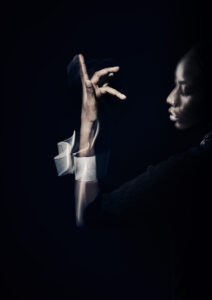
“wild waters” arm sculpture, recycled silver. photography: @XavierYoungPhoto
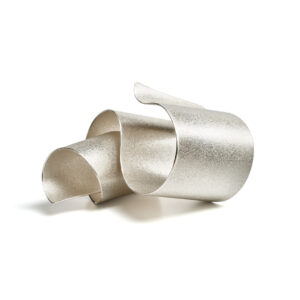
“rolling waves in moonlight” #5 sculptural brooch / pin, initialled & hallmarked 18 kt Fairtrade Gold 8.7 x 3.4 x 2.2 cm. photography: ute decker.
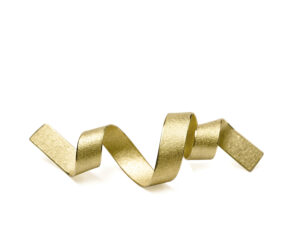
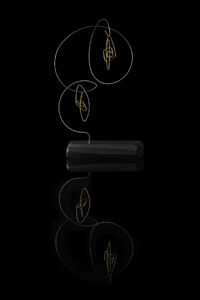
“improvisations on ovals”, 2022 sculptural earrings, initialled & hallmarked 18kt Fairtrade Gold 4 x 10 x 3 cm one earring – 4.3 grs. photography: @XavierYoungPhoto
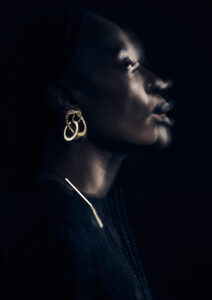
“the curling crest of a wave” sculptural ring, initialled & hallmarked 18 kt Fairtrade Gold. photography: ute decker
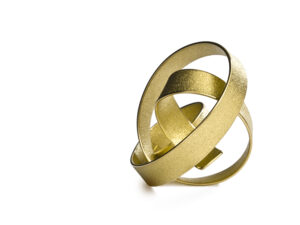
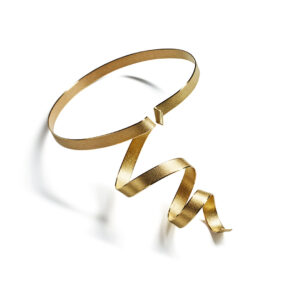
Transcript:
When it comes to ethical jewelry, artist-jeweler Ute Decker is the real deal. She was one of the first people to use Fairtrade gold when it became available in the U.K., and she has spent her career advocating for the use of truly ethically sourced materials in the jewelry industry. Above all, she’s proven that ethical can be beautiful: her sculptural works have won several awards and are in the collection of museums worldwide. She joined the Jewelry Journey Podcast to talk about what Fairtrade means; how she approaches the creative process; and what makes an artist-jeweler. Read the episode transcript here.
Sharon: Hello, everyone. Welcome to the Jewelry Journey Podcast. This is the second part of a two-part episode. If you haven’t heard part one, please go to TheJewelryJourney.com. Today my guest is Ute Decker, talking with us from London. Ute is an artist-jeweler who’s known for her innovative method of sculpting, bending and twisting metal into three-dimensional, wearable sculptures. She works in Fairtrade gold and recycled silver and is considered a pioneer in the international ethical jewelry movement. Welcome back.
So how did all of this lead you into recycled material? Was that something you decided you wanted to do, and that was it? How did it happen?
Ute: As we talked about at the beginning, as a teenager, I wanted to change the world. I was always quite environmentally mindful. Then studying political economics, working as a journalist, you think that is very far removed from being a creative, and at the time it certainly felt like a big break, but in hindsight I think it was an important apprenticeship I needed to take to become the jeweler I am today. As in political economics, you don’t just look at the piece and take it as art for art’s sake or design for design’s sake. You want to know the meaning, the context, the economic, the social, the political, the gender.
All those different histories and intersectionalities, that’s my training to look at those. As a journalist, your training is to ask questions, so when I started out making jewelry, I did ask questions. Like many people, I’ve seen the film “Blood Diamonds,” and I thought, “Oh well, thank god I don’t work with diamonds. I work with metals.” Then I started to look into gold, and the story is very similar to “Blood Diamonds” with gold. Of course, my reaction was, “I can’t possibly work with this kind of material. I can’t be part of the status quo. I’d have blood on my hands. It’s discretionary. It’s something I’m making. There’s absolutely no need for those horrible stories.” So, I researched quite a bit and asked many questions about ethics.
In 2009, when I started, there was no information out there whatsoever. In fact, I was met with a lot of hostility. Once you start asking about the ethics of jewelry, you’re tainting the story because jewelry is sold as that beautiful, luxurious love, but it’s such a tainted story. So, in the jewelry industry, those questions were certainly not welcome. I was met with either belittlement, “Don’t you worry. Everything is fine,” or outright hostility. I think as a journalist that meant, O.K., if people avoid your questions, that means you’re asking the right questions.
I searched high and low and found a like-minded person who’s been very active in that field. I was one of the very first to work with Fairtrade gold when it was launched in the U.K. It was together with Fairtrade and Fair Mined Gold. Those two organizations have now separated. I know in America more jewelers work with Fair Mined; in Europe, more work with Fairtrade but it’s very similar standards. The main thing is it’s fully traceable. We know exactly where it comes from. I know from which mine in the highlands of Peru my gold is coming from. I know it’s not smuggled out from the Congo, supporting atrocities there. I know it’s not smuggled out of Russia or somewhere else. It’s fully traceable, every single gram. I’m registered with the Fairtrade Foundation in the U.K. The mine is registered as well as the importer, and the refiner is registered. We all have a number and we all declare how much we buy, and it’s fully traceable. As a smaller maker, I’m audited every two to three years. I have to be able to show every single invoice; every single gram, I have to account for. It’s being checked. It is quite bureaucratic, but that is the guarantee. The whole Fairtrade ethos is trade not aid. It is about paying a fair price rather than the small-scale miner selling to middlemen, middlemen exploitation. It’s very much about dignity: avoiding child labor, more gender equality, environmental standards of not burning down the Amazon. Fairtrade gold and fair-mined gold is a little more expensive, but in the great scheme of things, it is worth it.
It’s also quite interesting that we started with just 20 jewelers. In 2009, we launched jewelry. All the other jewelers were also very small, individual jewelers. The entire industry said, “Traceability is not possible. Our gold is clean.” Well, where does it come from? “It’s clean.” But where? Traceability is impossible, we were told by the industry. Gold comes from all over the world, it’s then refined mostly in hubs like Switzerland or Dubai. The gold from all over the world comes through those hubs and then is distributed again all over the world. Gold has no identity, and they said it is absolutely impossible to have traceability. So, as 20 tiny, little jewelers, and unimportant jewelers in the great scheme of things, we gave the proof of concept that it was something that is possible. The entire industry no longer could deny that this was a possibility. Sometimes you get so disheartened thinking, “Whatever I do as an individual, what difference could it possibly make? It couldn’t be more than a drop in the ocean.” But the ocean is nothing but an accumulation of drops. We can change the waves. We can change. So, we have more power than we think we do.
Sharon: First, let me ask you: What is Fairtrade and Fair Mined? What is fair-trade gold?
Ute: I’ll answer both of them together because they started out together. It was called Fairtrade and Fair Mined gold. Later those two organizations separated, but they wrote the standards together, so they’re still very similar. When I say Fairtrade, you could almost consider it Fair Mined as well. They’re almost interchangeable. I think I did once read the standard. It’s pages and pages and pages of small print standards of environmental guidelines, of engaging with gender equality. It is about the minimum payments.
Quite often with small-scale miners, it’s not a job you do for fun. Artisanal sounds romantic, but it’s not. It’s a dollar-a-day, often horrible job, sometimes bonded labor, sometimes involving an awful lot of child labor. All of that is why the Fairtrade Foundation or Fair Mined works with the mine for a long time to come up to standard with certain environmental standards. They have to form a cooperative. We pay a premium that is then invested into community development. Women have a voice. Child labor is not allowed. Those mines are audited, and for their efforts they receive more money. It’s really enabling those miners to have more dignity, to live in a cleaner environment, to help protect the environment for all of us, and hopefully earn enough money for those children not to go down the shaft, but to go to school.
The question is, “Well, let’s just not use any gold at all,” which I also heartily agree with. But as we said, these miners almost subsist on a dollar a day, quite a few of those small-scale miners around the world. 100 million depend on that income, and it’s a poverty-stricken income. For us in the West to say, “Well, it would better if you didn’t do that,” is not going to work. It is helping those communities to work more environmentally friendly but also to earn more money to eventually get out of mining. It is a slower process. It’s not that we have all the answers. It’s a process of empowerment.
Sharon: How about the recycled silver you use? Do you only use recycled silver? How did Fair Mined lead you into only working with recycled silver?
Ute: Fairtrade and Fair Mines initially were only gold mines. When you mine gold, in the ore there is some silver, but it’s a much smaller percentage. So, there was availability of Fairtradegold, but very, very little of Fairtrade silver. Of course, it’s much cheaper to work with silver, so there would be a much higher demand. I would occasionally get a few grams of silver. I think now the availability of fair-mined silver is a little bit better. In fact, I’ve been told that it’s quite good now, so I need to look into that again. It is a continuous journey, but at the time and until recently, there was not just enough availability of Fairtrade silver. Otherwise, I would prefer to work in Fairtrade silver.
Recycled silver—now we call it recycled because we’re all so green; we used to call it scrapping. So, we’ve always done that. We’ve never thrown away precious metals. For me, it is not necessarily an ethical proposition to work in recycled. It is a little bit better than nothing, but I wouldn’t say I’m working ethical because I’m using recycled materials. I think that’s almost the bare minimum we should be using.
But then we come back to your earlier questions about art jewelry, artist jewelry, ethical jewelry. I don’t like the term ethical at all, ethical jewelry. It seems to be a standard term now. Sustainable jewelry, it definitely isn’t sustainable. We’re using finite resources. Responsible is probably a better term. I quite like mindful, but then mindful is so occupied with other things, so you can’t use that term. So, I use ethical jewelry as a term because I think we all know what we mean by that, but I don’t particularly like the term.
Sharon: Do your clients care? When you’re having a showing or people call about your jewelry and you mention it, does it make a difference to them how you’re working, whatever you want to call it? Do they care?
Ute: Not as much as I would have thought. Not as much as I do. It is not what people call a unique selling point; it’s not. If you do make small wedding bands, I think young couples, especially younger people, are much more engaged in that sustainable question. For them it’s much more important. People find their way first and foremost because there is something that speaks to you about the forms I make. It’s only afterwards, when they look closer and they see the materials I use. I think it is a certain appreciation of individually made, sculpted pieces that are unique even when I make a series, because they’re all hand sculpted. I will never be able to make the same piece again, so even with a series, pieces are unique.
If that somebody goes to the trouble and cares to choose the best material possible, I think that is appreciated, but nobody comes to me to buy a ring because it’s made in Fairtrade. I would love to stop talking about this subject because I would love it to be normal, nothing special anymore, but after being met with so much hostility all those years ago in 2011, if you look at any website of jewelers now—especially high street—they all proclaim to have responsible sourcing, conflict-free diamonds. As a consumer, if you look, you think, “Oh, thank god all of it has been sorted.” I think our biggest problem now—because there are more and more responsible and ethical options available—is greenwash.
Sharon: Greenwash, did you say?
Ute: Yeah, greenwash. Greenwash means painting the status quo green, changing nothing, just making it sound green. Unless you have fully traceable, unless you know 100% where your materials come from, you can’t make those claims. For me, using recycled is not necessarily ethical because there are huge issues with recycled. I’m always asked about that. I put a whole section on my website with several articles: “Is recycled or fair mined better?” because a lot of jewelers want to do the best. Rather than answering that question each time, I put quite a few articles on my website.
Sharon: May I ask you this about your jewelry, about something you said before? It’s always seemed to me that if you’re doing a show, you’re putting your work out there for people to judge. “Yes, I want a ring like that,” or “No, it doesn’t appeal to me,” and they move onto the next thing. It must take thick skin.
Ute: Interesting question. You would think so. Before I outed myself, I made jewelry for myself for nearly 20 years. I made what I wanted to wear, what I enjoyed. For me, it was totally unimportant if anybody else liked it.
Sharon: Are the pieces you make for the shows pieces you like or pieces you want to make?
Ute: When I started out only making jewelry for myself, I didn’t show it to anybody. I made it for myself. It was out of interest and the creative joy of it. I wore the pieces, and it didn’t matter whether somebody liked it. Then I accidentally showed my work for the first time, and I thought, “Who else is going to like this? I love it and some of my friends do, but maybe they’re just being nice.” I did win a prize and things happened. It’s quite amazing, to my greatest surprise, that several of my pieces are now in several museums including the V&A. I would have never, ever thought so. I think as any creative, to be authentic, you can’t try to please everybody. You don’t want to please everybody. It’s wonderful that there are several people out there in the world who think that what I do speaks to them, but I’m quite happy for many people to just walk past.
Sharon: It doesn’t matter.
Ute: Yes, it doesn’t matter. There are some lovely older ladies who come. They giggle and say, “Oh, you couldn’t do the gardening with that one.” I love that comment. It’s still engaging, and they’re interested in the shapes. It’s so obvious it’s not for them, but they still engage in a way. Jewelry, for me, is a way of making connections. You can’t connect with absolutely everybody, but when it makes those connections, it’s beautiful. So no, I don’t have thick skin, because I guess enough sparkling eyes gives me joy as well. I see artwork that others are enthused about, and it doesn’t speak to me. Maybe a few years later it does. So no, I’m not trying to please anybody. It’s a joy that there are many people I can share the work with.
Sharon: Your work is unusual, but if your work is not for gardening, as these women say, who is it for? Is it for younger people? Is it for people who appreciate the art and when they go garden, they’ll put it aside? Who is it for?
Ute: Every piece I make is a piece I want to wear. Maybe in a way it’s firstly for me, so I can keep making them. I sell my work to support my habit. Mostly the people who are drawn to my work are mature, mostly women, but also men. Mature people who are confident that come in all shapes, sizes, ages, everything, but who feel quite confident wearing a piece like the ring I’m wearing or the beautiful ring you’re wearing.
Jewelry can also be very empowering. You put on a piece, and here I am talking nonstop, but I can be quite shy. Being in a gathering of people, especially for me to go up to somebody, yeah, I dread being in groups of people. When you wear a piece, it allows other people to approach you. It gives that invitation to speak to you. It doesn’t say, “Hey, look what a cool piece I’m wearing.” It says, “Yes, I’m open to have a conversation.” It’s amazing how many doors wearing my jewelry has opened. Then you start a conversation, and it naturally flows. Coming back to the question, it is for confident people, but it’s also for non-confident people like myself. It’s both.
Sharon: I can see how it would be for confident people. I invite everybody to take a look at our website. We’ll have picture. It’s very unusual jewelry. I really appreciate you being here today. Thank you so much.
Ute: Thank you. That time passed very quickly, Sharon. Thank you.
Thank you again for listening. Please leave us a rating and review so we can help others start their own jewelry journey.

